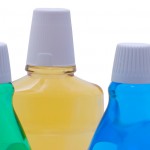
Chlorhexidine mouthwash is regularly advised as an adjunct to oral hygiene procedures and there is high quality evidence to support its short-term use to reduce plaque and gingivitis. However it is also know to cause tooth staining.
The aim of this review was to assess whether chlorhexidine mouthwash with an anti-discoloration system is effective in preventing extrinsic tooth surface discoloration and whether it maintains its efficacy.
Methods
Searches were conducted in the Medline/PubMed, Cochrane CENTRAL, OpenGrey, European Federation of Periodontology and the International Association for Dental Research databases. Randomised controlled trials (RCTs) or controlled clinical trials (CCTs) comparing chlorhexidine mouthwash with an anti-discolouration system against chlorhexidine mouthwash alone were considered. Two reviewers independently screened and selected studies, extracted data and assessed study quality. Meta-analysis was conducted where feasible and the overall body of evidence was assessed using the GRADE approach.
Results
- 13 RCTs (7 cross-over, 6 parallel) with 16 comparisons were included.
- 6 comparisons used a non-brushing model, 10 compared mouthwash as an adjunct to toothbrushing.
- Study duration ranged from 4 to 35 days.
- A majority of studies used CHX at a concentration of 0.20% with 2 studies using 0.12% and 1 study 0.09%.
- A statistically significant benefit in favour of stain reduction was ADS mouthwash was seen in a majority of studies
- A majority of the studies demonstrated no differences in bleeding, gingivitis and plaque scores.
- Meta-analysis for non-brushing experiments,
- the difference-of-means (DiffM) for plaque index= 0.10 (95%CI: -0.15; 0.34) [5 studies] and
- 0.04 (95%CI: -0.02; 0.11) for the gingival index [3 studies].
- For the brushing studies DiffM for plaque index= 0.01(95%CI: -0.01; 0.02) [4 studies]
- and 0.00 (95%CI: -0.05; 0.06) for the gingival index [2 studies].
- For staining meta-analysis showed no difference in staining for toothbrushing studies mean difference = 0.12(95% I: −3.32; 3.55) [2 studies] and a significant difference for non-brushing studies SMD = −3.19 (95%CI: −3.98; −1.41) [4 studies].
Conclusions
The authors concluded: –
There is moderate quality evidence from non-brushing studies that the addition of an ADS to CHX-MW reduces tooth surface discoloration and does not appear to affect its properties with respect to gingival inflammation and plaque scores. In brushing studies, there is also moderate quality evidence that ADS does not affect the anti-plaque and anti-gingivitis efficacy of CHX. The majority of comparisons and the meta-analysis including these indicate no significant effect of ADS on tooth staining in situations where the mouthwash is used in addition to toothbrushing.
Comments
The 2017 Cochrane review (Dental Elf – 3rd Apr 2017) found high quality evidence for a reduction of plaque and gingivitis with the use of chlorhexidine mouthwash in the short term. However, the Cochrane review also highlighted that rinsing with chlorhexidine mouthrinse for 4 weeks or longer causes extrinsic tooth staining. This well conducted systematic review identified a 13 RCTs found a significant benefit for stain reduction with the use of an anti-discolouration system and evidence that this did not affects its anti-gingivitis and anti-plaque activity. While the review found a statistically significant difference in the staining levels it is not clear whether the difference in staining is aesthetically obvious to patients. As a majority of the studies also recommended dietary restrictions e.g avoiding tea, coffee red wine intake the levels of stain reduction may not be reflected in real world situations.
Links
Primary Paper
Van Swaaij BWM, van der Weijden GAF, Bakker EWP, Graziani F, Slot DE. Does chlorhexidine mouthwash, with an anti-discoloration system, reduce tooth surface discoloration without losing its efficacy? A systematic review and meta-analysis.Int J Dent Hyg. 2019 May 3. doi: 10.1111/idh.12402. [Epub ahead of print] Review.PubMed PMID: 31054209.
Other references
Dental Elf – 3rd Apr 2017
